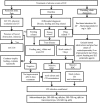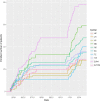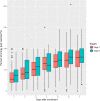Effectiveness of enteral feeding protocol on clinical outcomes in critically ill patients: A before and after study
- PMID: 28771622
- PMCID: PMC5542540
- DOI: 10.1371/journal.pone.0182393
Effectiveness of enteral feeding protocol on clinical outcomes in critically ill patients: A before and after study
Abstract
Background and objective: Enteral nutrition (EN) feeding protocol was proposed to have positive impact on critically ill patients. However, current studies showed conflicting results. The present study aimed to investigate whether enteral feeding protocol was able to improve clinical outcomes in critically ill patients.
Methods: A before (stage 1) and after (stage 2) interventional study was performed in 10 tertiary care hospitals. All patients expected to stay in the intensive care unit (ICU) for over three days were potentially eligible. Clinical outcomes such as 28-day mortality, ICU length of stay, duration of mechanical ventilation (MV), and nosocomial infection were compared between the two stages.
Main results: A total of 410 patients were enrolled during the study period, including 236 in stage 1 and 174 in stage 2. EN feeding protocol was able to increase the proportion of EN in day 2 (41.8±22.3 vs. 50.0±28.3%; p = 0.006) and day 6 (70.3±25.2 vs. 77.6±25.8%; p = 0.006). EN percentages tended to be higher in stage 1 than that in stage 2 on other days, but statistical significance was not reached. There was no difference in 28-day mortality between stage 1 and 2 (0.14 vs. 0.14; p = 0.984). Implementation of EN feeding protocol marginally reduced ICU length of stay (19.44±18.48 vs. 16.29±16.19 days; p = 0.077). There was no difference in the duration of MV between stage a and stage 2 (14.24±14.49 vs. 14.51±17.55 days; p = 0.877).
Conclusions: The study found that the EN feeding protocol was able to increase the proportion of EN feeding, but failed to reduce 28-day mortality, incidence of nosocomial infection or duration of MV.
Conflict of interest statement
Figures






Similar articles
-
The effects of an enteral nutrition feeding protocol on critically ill patients: A prospective multi-center, before-after study.J Crit Care. 2020 Apr;56:249-256. doi: 10.1016/j.jcrc.2020.01.018. Epub 2020 Jan 17. J Crit Care. 2020. PMID: 31986368
-
[Impact of permissive underfeeding versus standard enteral feeding on outcomes in critical patients requiring mechanical ventilation: a prospective randomized controlled study].Zhonghua Wei Zhong Bing Ji Jiu Yi Xue. 2018 Feb;30(2):176-180. doi: 10.3760/cma.j.issn.2095-4352.2018.02.016. Zhonghua Wei Zhong Bing Ji Jiu Yi Xue. 2018. PMID: 29402370 Clinical Trial. Chinese.
-
Calorie intake of enteral nutrition and clinical outcomes in acutely critically ill patients: a meta-analysis of randomized controlled trials.JPEN J Parenter Enteral Nutr. 2015 Mar;39(3):291-300. doi: 10.1177/0148607114544322. Epub 2014 Jul 30. JPEN J Parenter Enteral Nutr. 2015. PMID: 25078609
-
The impact of implementation of an enteral feeding protocol on the improvement of enteral nutrition in critically ill adults.Asia Pac J Clin Nutr. 2017 Jan;26(1):27-35. doi: 10.6133/apjcn.122015.01. Asia Pac J Clin Nutr. 2017. PMID: 28049258 Review.
-
Reducing costs and patient morbidity in the enterally fed intensive care unit patient.JPEN J Parenter Enteral Nutr. 2005 Jan-Feb;29(1 Suppl):S62-9. doi: 10.1177/01486071050290S1S62. JPEN J Parenter Enteral Nutr. 2005. PMID: 15709547 Review.
Cited by
-
Effects of early standardized enteral nutrition on preventing acute muscle loss in the acute exacerbation of chronic obstructive pulmonary disease patients with mechanical ventilation.World J Emerg Med. 2023;14(3):193-197. doi: 10.5847/wjem.j.1920-8642.2023.046. World J Emerg Med. 2023. PMID: 37152533 Free PMC article.
-
Actively implementing an evidence-based feeding guideline for critically ill patients (NEED): a multicenter, cluster-randomized, controlled trial.Crit Care. 2022 Feb 16;26(1):46. doi: 10.1186/s13054-022-03921-5. Crit Care. 2022. PMID: 35172856 Free PMC article. Clinical Trial.
-
Optimal Nutritional Factors Influencing the Duration of Mechanical Ventilation Among Adult Patients with Critical Illnesses in an Intensive Care Unit.J Multidiscip Healthc. 2021 Jun 10;14:1385-1393. doi: 10.2147/JMDH.S319553. eCollection 2021. J Multidiscip Healthc. 2021. PMID: 34140776 Free PMC article.
-
Enteral nutrition feeding in Chinese intensive care units: a cross-sectional study involving 116 hospitals.Crit Care. 2018 Sep 24;22(1):229. doi: 10.1186/s13054-018-2159-x. Crit Care. 2018. PMID: 30244686 Free PMC article.
-
The implementation of a nutrition protocol in a surgical intensive care unit; a randomized controlled trial at a tertiary care hospital.PLoS One. 2020 Apr 16;15(4):e0231777. doi: 10.1371/journal.pone.0231777. eCollection 2020. PLoS One. 2020. PMID: 32298381 Free PMC article. Clinical Trial.
References
-
- Zhang Z, Chen K, Ni H, Fan H. Predictive value of lactate in unselected critically ill patients: an analysis using fractional polynomials. J Thorac Dis. 2014;6: 995–1003. doi: 10.3978/j.issn.2072-1439.2014.07.01 - DOI - PMC - PubMed
-
- Stuani Franzosi O, Delfino von Frankenberg A, Loss SH, Silva Leite Nunes D, Rios Vieira SR . Underfeeding versus full enteral feeding in critically ill patients with acute respiratory failure: a systematic review with meta-analysis of randomized controlled trials. Nutr Hosp. 2017;34: 19–29. doi: 10.20960/nh.443 - DOI - PubMed
-
- Hofman Z, Swinkels S, van Zanten ARH. Glutamine, fish oil and antioxidants in critical illness: MetaPlus trial post hoc safety analysis. Ann Intensive Care. Springer Paris; 2016;6: 119 doi: 10.1186/s13613-016-0220-y - DOI - PMC - PubMed
-
- Havens JM, Columbus AB, Seshadri AJ, Olufajo OA, Mogensen KM, Rawn JD, et al. Malnutrition at Intensive Care Unit Admission Predicts Mortality in Emergency General Surgery Patients. JPEN J Parenter Enteral Nutr. SAGE PublicationsSage CA: Los Angeles, CA; 2016;43: 014860711667659. doi: 10.1177/0148607116676592 - DOI - PubMed
-
- Lew CCH, Yandell R, Fraser RJL, Chua AP, Chong MFF, Miller M. Association Between Malnutrition and Clinical Outcomes in the Intensive Care Unit: A Systematic Review. JPEN J Parenter Enteral Nutr. SAGE PublicationsSage CA: Los Angeles, CA; 2016;5: 014860711562563. doi: 10.1177/0148607115625638 - DOI - PubMed
MeSH terms
LinkOut - more resources
Full Text Sources
Other Literature Sources
Research Materials

